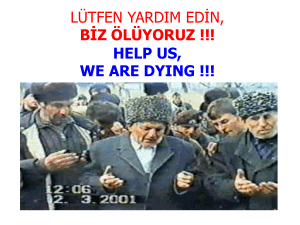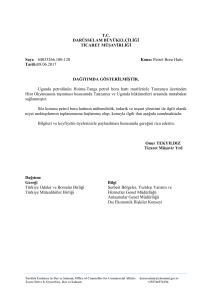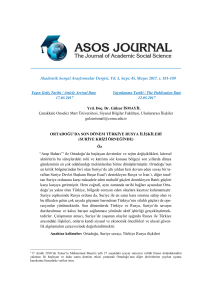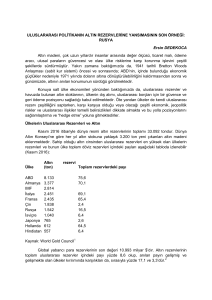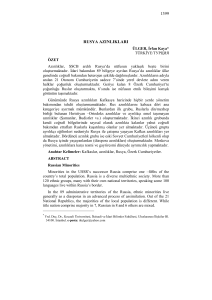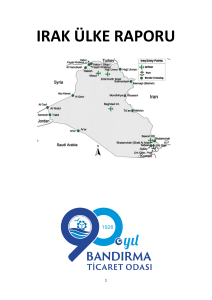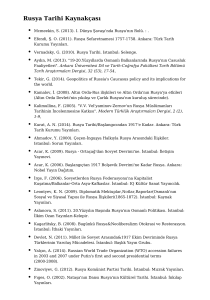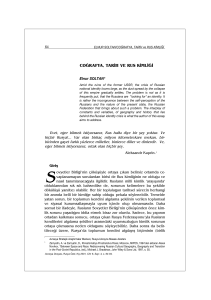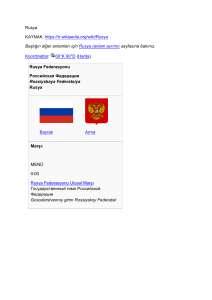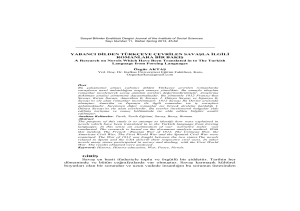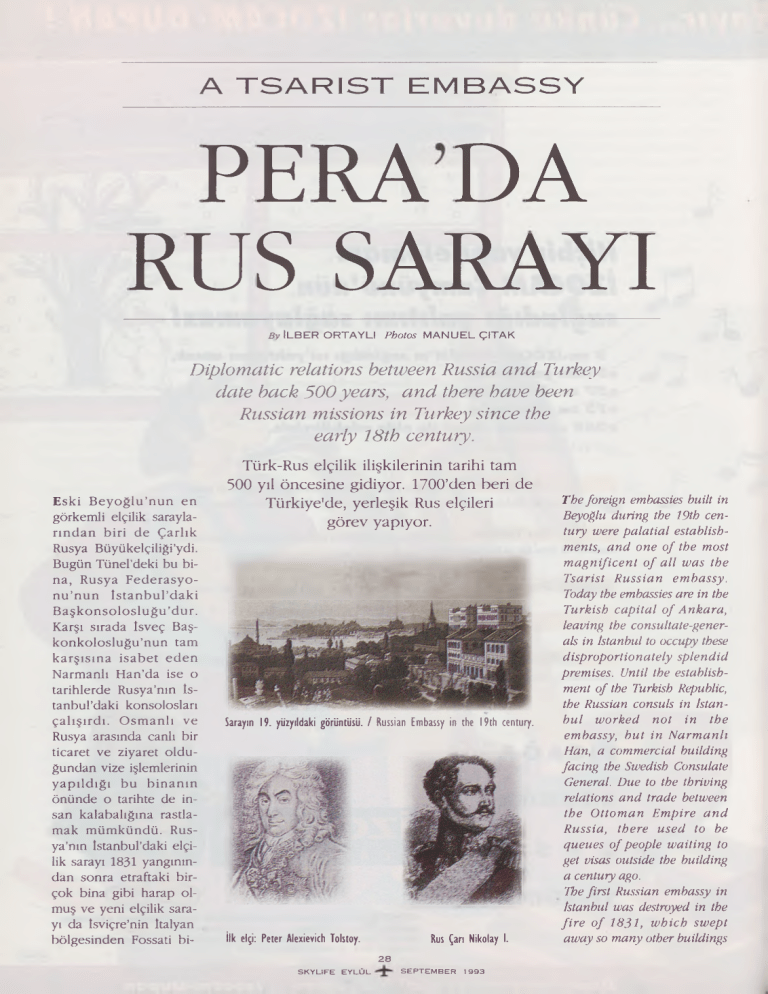
A TSARIST EMBASSY
PERADA
RUS SARAYI
Z fy lL B E R O R T A Y L I Photos M A N U E L Ç IT A K
Diplomatic relations between Russia and Turkey
date back 500years, and there have been
Russian missions in Turkey since the
early 18th century.
Eski B eyoğlu’nun en
görkemli elçilik sarayla­
rından biri de Çarlık
Rusya Büyükelçiliğindi.
Bugün Tünel’deki bu bi­
na, Rusya Federasyo­
num un İstan b u l’daki
B aşkonsolosluğu’dur.
Karşı sırada İsveç Başkonkolosluğu’nun tam
karşısına isabet eden
Narmanlı Han’da ise o
tarihlerde Rusya’nın İs­
tanbul’daki konsolosları
çalışırdı. Osm anlı ve
Rusya arasında canlı bir
ticaret ve ziyaret oldu­
ğundan vize işlemlerinin
yapıldığı bu binanın
önünde o tarihte de in­
san kalabalığına rastla­
mak mümkündü. Rus­
ya’nın İstanbul’daki elçi­
lik sarayı 1831 yangının­
dan sonra etraftaki bir­
çok bina gibi harap ol­
muş ve yeni elçilik sara­
yı da İsviçre’nin İtalyan
bölgesinden Fossati bi-
Türk-Rus elçilik ilişkilerinin tarihi tam
500 yıl öncesine gidiyor. 1700’den beri de
Türkiye'de, yerleşik Rus elçileri
görev yapıyor.
Sarayın 19. yüzyıldaki görüntüsü. / Russian Embassy in the 19th century.
İlk elçi: Peter Alexievich Tolstoy.
Rus Çarı Nikolay I.
28
SKYUFE
EYLÜL
SEPTEM BER
1993
The foreign embassies built in
Beyoğlu during the 19th cen­
tury were palatial establish­
ments, a n d one o f the most
m a g n ificen t o f all was the
Tsarist R ussian em bassy.
Today the embassies are in the
Turkish capital o f A nkara,
leaving the consultale-generals in Istanbul to occupy these
disproportionately splendid
premises. Until the establish­
ment o f the Turkish Republic,
the Russian consuls in Istan­
b u l w orked not in the
embassy, b u t in N arm anlı
Han, a commercial building
facing the Swedish Consulate
General. Due to the thriving
relations a n d trade between
the O ttom an E m pire a n d
Russia, there used to be
queues o f people w aiting to
get visas outside the building
a century ago.
The first Russian embassy in
Istanbul was destroyed in the
fir e o f 1831, w hich swept
away so many other buildings
29
SKYLIFE
E Y LG L-^-
SEPTEM BER
1993
in Beyoğlu. The Swiss Fossati brothers, Giuseppe a n d
raderlere ısmarlanmıştı. Bina tamamlandığında yerli,
Caspare, from the Italian region o f Switzerland, were com­
yabancı herkesin dikkatini çekmişti. Fossatiler (Gi­
missioned to design a n d build a new embassy, which
useppe ve Caspare) mimar olarak Rusya devletinin
became the talk o f the town when it was revealed in all its
hizmetindeydi. Bu konuda Profesör Semavi Eyice’nin
splendour. According to Professor Semavi Eyice, the project
tespitlerine göre, halk arasında Çar “İstanbul’da saray
aroused popular rumours that the Tsar was “building a
yaptırıyor” diye dedikodular olmuş (“Fossati” İstan­
palace in Istanbul”. The Dutch were so impressed by the
bul Ansiklopedisi, C. XI). HollandalIlar da yeniden
Russian embassy that they hired the Fossati brothers to
yaptırırken bu güzellikten etkilenmişler ve yeni elçi­
build a new embassy fo r them, too. The Ottoman govern­
lik binasını Ruslar gibi, Fossatilere ısmarlamışlardı.
ment followed suit, commissioning several ministries, a
Derken İstanbul tarafından bir takım Nezaret (bakan­
state archive building (which now stands behind the gover­
lık) binaları, hatta Devletin arşiv binası (bugünkü Va­
n o r’s office in Cağaloğlu), a n d a new university, the
lilik arkasında) Darülfünun (üniversite-sonra Adliye
Darülfünun (this later housed the Law Courts). The Italian
oldu) bu mimarlara inşa ettirilmişti. O kadarla da kal­
neo-Renaissance style popularised by the Fossatis spread
madı. İtalyanların bu dönemdeki yeni rönesans üslû­
like wildfire through Russia and the Ottoman Empire, so it
bu Rusya gibi Osmanlı İmparatorluğu’nu da etkiledi­
is no surprise to fin d that many government buildings in
ğinden, ülkenin her tarafında bu biçim tercih edildi.
the provincial towns o f both countries bear a close resem­
Eski Rusya’nın başkent ve taşra şehirlerindeki bazı
blance. Next the Fossatis were entrusted with the m onu­
binalarla, Osmanlı vilayetlerindeki resmi binaların usmental task o f restoring the form er Byzantine church o f
lûb benzerliği tesadüf sayılmamalıdır. Derken AyaH aghia Sophia, then a m osque a n d
sofya’nın restore edilmesi işini de Fos­
today a museum. Illustrations made by
sati biraderlere bıraktılar. Büyük ve
1700 yılının Temmuz
Caspare Fossati o f the Byzantine frescos
muhteşem binanın restorasyonu sıra­
a
n d mosaics in this vast and splendid
sında fresk ve mozayikleri kopya
babında Rusya ve Osmanlı
building were published in 1852, the
eden Caspare Fossati, bunları Sultan
Devleti arasında imzalanan
cost being met by Sultan Abdiilmecid.
A bdülm ecid’in cöm ert desteğiyle
When the Crimean War broke out in
1852’de bastırdı.
İstanbul Barış Antlaşması
1853, the Russian diplomatic sta ff left
1853’te Kırım Savaşı çıkıp sefir ve dip­
ile imparatorluk
Istanbul. The embassy was used as their
lomatik erkân Başkent’ten ayrılınca,
başkentine ilk yerleşik elçi
headquarters by the French forces in the
müttefik Fransız kuvvetlerin İstan­
city, and suffered extensive damage. In
bul’daki karargâh merkezi olan Elçi­
geldi. İstanbul, ünlii yazar
1858, a fter p ea ce was restored, the
lik büyük tahribe uğradı. Barıştan
Lev Tolstoy’un ceddi Pyotr
Ottoman government had the building
sonra 1858’de Babıâli, Rusya Sefarerepaired before handing it back to the
ti’ni tamir ettirerek sahiplerine teslim
Alekseyeviç Tolstoy ile
Russians.
etti. Rusya ile 1492’den beri elçilik iliş­
böylece tanıştı.
Although diplomatic relations between
kileri içinde olduğum uz biliniyor.
Russia a n d the O ttom ans date fro m
Ama İstanbul’da devamlı bir Rus Elçi­
1492,
it
was
not
until
the 18th century that the first im m a ­
liği 18. asrın başında kuruldu. 1863 Viyana kuşatma­
nent
Russian
mission
was
established in Istanbul. Since the
sından beri Osmanlılar, içlerinde Rusya’nın da bulun­
Siege
o
f
Vienna
in
1683,
the Ottoman Empire had been
duğu kutsal ittifak devletleriyle uzun savaşlar
engaged
in
a
series
o
f
long
wars with the countries o f the
yürütüyordu. Devleti yıpratan bu savaşlar 1699 KarHoly
A
lliance
(Austro-Hungary,
Prussia a n d Russia),
lofça Antlaşması’yla sona erdi. 1700 yılının Temmuz
which
left
the
empire
debilitated.
These
wars were brought
başında Rusya ve Osmanlı Devleti arasında imzala­
to
an
end
with
the
Carlowitz
Treaty
o
f
1699,
and in early
nan İstanbul Barış Antlaşması ile imparatorluk baş­
July
1700
after
a
peace
treaty
was
signed
by
Russia and
kentine ilk yerleşik elçi geldi. İstanbul, ünlü yazar
Turkey,
the
first
perm
a
n
en
t
Russian
am
bassador
was
Lev Tolstoy’un ceddi Pyotr Alekseyeviç Tolstoy ile
accredited
to
the
Ottoman
court.
So
it
was
that
Istanbul
böylece tanıştı, ilk sefirin hareketli etkin ve sıkıntılı
made the acquaintance o f Peter Alexievich Tolstoy, ances­
bir hayatı oldu. Çünkü arada, o devirde Türklerin
tor
o f the fam ous writer Lev Tolstoy. This first ambassador
“deli” diye adlandırdıkları Çar Büyük Petro ile 1711
had
an eventful and troublesome term o f office, coinciding
Prut savaşı da yapılmıştı. 1714’de sefir Pyotr Tolstoy
with
the Battle o f Prut in 1711 against Tsar Peter the Great,
İstanbul’dan görevini tamamlamış yorgun bir diplo­
known as “the Mad" in Turkey. Ihe exhausted Peter Tolstoy
mat olarak ayrıldı. Osmanlı İmparatorluğu’nun siyasi,
left Istanbul fo r home in 1714. His extensive reports, often
askeri, toplumsal durumu hakkında kaleme aldığı,
hundreds o f pages long, about the political, military and
bazen yüzlerce sayfaya ulaşan, raporları bugün tarih­
social conditions o f the Ottoman Empire are today valuable
çiler için önemli kaynaklardandır.
sources fo r historians.
Rusya tarihinin diğer önemli soylu bir ailesi de IgnaAnother aristocratic fam ily which featured prominently in
tievlerdi. İstanbul’daki Elçilik Sarayı’nda bu ailenin
30
S K Y L İF E
EYLÜL
SEPTEM BER
1993
1923’de Ankara Başkent olunca bütün elçilikler belirli bir süre içinde oraya taşındı. Beyoğlu’ndaki güzel ve görkemli bina ise Rus Başkonsolosluğu oldu.
İn 1923, the former Soviet embassy became the Consulate General, and hosted some of the famous figures of the new regime during their visits to Turkey.
Russian history was the Ignatievs. One o f its members,
General Nikolai Pavlovich Ignatiev, who arrived in Istan­
bul in 1864, became one o f the most influential diplomats
in the city. Ignatiev had proved his worth as an efficient
administrator in provincial government, before transfer­
ring to the foreign service. In Istanbul he made masterful
use o f a common technique o f 19th century diplomacy,
which was to spread false rumours amongst his fellow
diplomats. Ihese deceptions annoyed the European diplo­
matic corps in Istanbul even more than the Ottoman gov­
ernment. Ignatiev was a personal friend o f Grand Vizier
M. Nedim Pasha, and the pair undoubtedly engaged in
intrigues against the other European ambassadors. As his
grandson, Michael Ignatiev wrote ( The Russian Album,
1987), Ignatiev had established a highly efficient intelli­
gence network am ong the Christian m inorities o f the
empire, through which he obtained up-to-date news and
was able to intervene in the course o f events in his coun­
try's interests. The embassy in Beyoğlu became an influen­
tial a n d dynam ic centre fo r the Balkan Slavs, a n d the
name o f Ignatiev was on everyone’s lips, not only in the
turbulent Balkans, but at the Sublime Porte, the foreign
embassies, and as fa r afield as Syria and Palestine.
When war broke out once more between Russia and Turkey
in 1877, Ignatiev left Istanbul a n d raced to the Tsar's
headquarters a t Plevna, as was the wont o f Russian
ambassadors under similar circumstances. One ambas-
bir ferdi de uzun süre sefir olarak bulundu; General
Nikolai Pavloviç Ignatiev 1864’de geldiği İstanbul’da
en etkili diplomatlardandı. General Ignatiev daha ön­
ce Rusya devletinin çeşitli kademelerinde yükselmiş,
taşra yönetiminde ve dışişlerinde başarılı olmuş, yete­
nekli bir yöneticiydi. İstanbul'da o devir diplomasisi­
nin bir tekniğini de ustalıkla uyguladı; asılsız haberle­
ri diğer meslekdaşları arasında yayıp onları yanıltma­
sı, BabIâli’den çok Avrupalı diplomadan çileden çıka­
rıyordu. Sadrazam M. Nedim Paşa ile dosttu. Muhte­
melen Avrupalı elçilere karşı müştereken bazı entri­
kalar yürütüyorlardı. Ama doğrusu torunlarından Michael Ignatiev’in de yazdığı gibi (The Russian Albüm,
1987) Osmanlı Devleti’nin bütün Hıristiyan tebaası
arasında ne olup bittiğini anında öğrenen ve yönlen­
diren güçlü bir istihbarat ağı kurmuştu. Beyoğlu’nda­
ki Büyükelçilik Balkan Slavları için etkin ve dinamik
bir merkez haline gelmişti. Ignatiev ismi, kaynayan
Balkanlar kadar, Suriye ve Filistin’de, sefarethaneler­
de ve Babıâli’de en çok anılan isim haline geldi.
1877’de Rusya ve Türkiye arasında harp patladığında
İstanbul’dan ayrıldı ve Plevne’de karşı cephede Çar’m
karargahında görev aldı. Rusya elçilerinin kaderi ge­
nellikle savaş patlayınca İstanbul’dan ayrılmaktı. Ama
içlerinden birisinin bu ayrılışını bir zaman sonra dra­
matik bir dönüş izleyecektir. Bu, İstanbul’daki son
Rusya Büyükelçilerinden biri olan Çarikov’du. Iktisa32
S K Y L IF E
EYLÜL
SEPTEM BER
1993
k
34
S K Y L IF E
EYLÜL
SEPTEM BER
1993
sador, however, made a dramatic return shortly after such
di, siyasi konularda bilgili; Balkanları ve Osmanlı tma departure. This was Charikov, one o f the last Russian
paratorluğu’nu iyi bilen bir uzmandı. Kader, ihtilal
ambassadors in Istanbul. Charikov was knowledgeable
yıllarında onu İstanbul’a sürükledi. Büyükelçi olarak
about both econom ic a n d political affairs, a n d wellayrıldığı şehre mülteci olarak döndü, karısı ile sıkıntı
informed on the Balkans and the Ottoman Empire. Fate
içinde bir hayat yaşayarak ömrünü noktaladı. Çar
brought him a n d his wife hack to Istanbul as refugees
Rusyası’nın son büyükelçisi Giers, 2 Kasım 19l4’de
from the Bolshevik Revolution, and he died there in much
her iki imparatorluk için de sonun başlangıcı olan
straitened circumstances.
büyük savaş patladığında İstanbul’u terketti. Bir daha
The last ambassador o f Tsarist Russia in Istanbul. Giers,
bu şehirde onu izleyen bir Rusya Büyükelçisi olmadı.
departed on 2 November 1914 after the outbreak, o f the
Türkiye Büyük Millet Meclisi Hükümeti Anadolu’da
Great War, which was to end in the dow nfall o f hath
mücadeleye başladığında yeni başkent Ankara’ya ilk
Ottoman and Russian empires. No other Russian ambas­
gelen, Sovyetler hükümetinin büyük elçisi Aralov idi.
sador ever came to Istanbul, hut the Soviet Union s ambas­
1923’de Ankara Başkent olunca bütün elçilikler belirli
sador Aralov teas the first foreign ambassador to arrive in
bir süre içinde oraya taşındı. Yeni Sovyet Rusya Elçi­
Ankara, while the Turkish government was stillfighting fo r
liği zaten oradaydı. Beyoğlu’ndaki güzel ve görkemli
the country 's independence in Anatolia. Not until after the
bina Başkonsolosluk oldu. Bir dönem yeni Rusya’nın
Turkish Republic was established in 1923 did the other
ünlü simalarını Türkiye ziyaretlerinde misafir etti. II.
embassies start moving to A nkara. The fo rm er Soviet
Dünya Savaşı’ndan sonraki soğuk harp yıllarında,
embassy became the consulate general, and hosted some o f
Rusya’nın eski görkemli sarayı şehirde sadece belirli
the fam ous figures o f the netv regime dur­
günlerde verilen resepsiyonlarda işa­
ing their visits to Turkey. In the years o f the
damlarının ve protokole mensup kim­
cold war following World War II, however,
Today, thanks to revived
selerin uğradığı, gerginliğin ve soğuk­
this magnificent building retreated behind
luğun arkasında kaybolan bir Başkon­
commercial, cultural and
a distant a n d forbidding cloud, visited
solosluktu. Bugün Rusya ve Türkiye
scientific relations
only by businessmen and officials invited
arasında canlanan ticari, kültürel bi­
to sporadic receptions. Today that cloud
limsel ilişkiler dolayısıyla, bu güzel bi­
between Russia and
has dispersed, and thanks to revived com­
na nerede ise her İstanbullunun uğra­
Turkey, this beautiful
mercial, cultural a n d scientific relations
dığı işlek bir diplomatik ve konsüler
between Russia and Turkey, this beautiful
building has regained
m erkez haline geldi. Eski Rusya
building has regained much o f the anim a­
Büyükelçiliği civarındaki Venedik Elçi­
much of the animation
tion which it enjoyed in the 19th century.
lik Sarayı ile birlikte İstanbul’un nadi­
which it enjoyed in the
Only the form er Venetian embassy in the
de incilerinden biridir. 19- yüzyılda iki
same district can compete with the Russian
ülkeyi de etkileyen aynı mimari stil ve
19th century.
embassy in aesthetic terms, and the latter
okulun en canlı görkemli bir örneği­
is a fascinating illustration o f the way in
dir. Herhangi bir seyahat rehberi kita­
which one style affected tu>o countries.
bında Rusya Sarayı’ndan sözedildiği görülmez. Onun
No guide hooks mention the Russian Consulate General,
için bu binanın denizden şehre hakim ön cephesini
although the seaward facade in particular deserves close
özellikle seyretmelidir. Rusya Elçiliği nin küçük kilise­
examination. In the past, the chajxtl here was an impor­
si de binanın eskiden önemli bir parçasıydı. Yukarda
tant part o f the building. Narmanli Han, in ivhich the
sözünü ettiğimiz Narmanlı Han geçen asırda Rusya
consular offices were housed in the last century, is one o f
Elçiliği’nin ofis binası olarak kullanılırdı. Ön cephe­
the finest examples o f Russian neo-Renaissance architec­
deki yarım sütunlarıyla Rusya’daki neorönesans stilin
ture, with demi-columns adorning the facade. At some
bizdeki nadir örneklerinden biridir. Bugün ticari bir
point in the 19th century, a meyhane (drinking shop) here
handır. Geçen asırda bir ara bu civarda açılan bir
was closed down as being out o f keeping with its diplomat­
meyhane diplomatik teamüle uymadığı için yıkılmıştı.
ic su rro u n d in g s, a n d even to d a y the low er e n d o f
Gerçekten Beyoğlu Caddesi’nin Tünel tarafı elçilik bi­
Beyoglu’s main street is less lively, the embassy buildings
naları yüzünden oldukça hareketsiz ve resmi bir
giving it an official air. At the same time, the large gar­
hüviyettedir. Fakat eski sefaret saraylarının bahçeleri
dens o f the former embassies have made this the greenest
sayesinde de, şehrin içinde en yeşil ve pitoresk bir
area o f centra! Istanbul. O f the large num ber o f White
bölge olarak kalabilmiştir. Ekim ihtilalinden sonra İs­
Russian refugees who flocked to Istanbul after the October
tanbul’u dolduran kalabalık Rus mülteciler kısa za­
Revolution, many disfxrsed elseu’bere within a short time,
manda azaldılar ve bugün onlardan kimse kalmadı.
a n d o f those who settled here none remain today. The
Eski Rus Arkeoloji Enstitüsü de 1920’li yıllarda İstan­
Russian Archaeological Institute closed down in the 1920s,
bul’u terketti. İhtilal öncesi Rusya tarihinden daha
never to return. The form er embassy in Beyoglu is the sole
doğrusu iki imparatorluğun müşterek tarihinden ka­
sunw ing witness to the shared history o f the two empires. •
lan tek anı, Beyoğlu’ndaki Elçilik Sarayı’dır.
•
35
S K Y L IF E
EYLÜL
SEPTEM BER
1993

